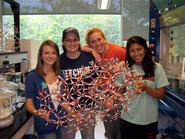
Clathrate hydrates are like cages. They are sculptures of ice-like water-based solids that can trap very small molecules inside of them. Studying their behavior can help decide what uses they might have and what kind of industries could benefit from their reactions.
This summer, Kristen Pallen ’12, Emina Memisevic ’12, Melissa Nezamzadeh ’11 and Lisa Olszewski ’11 are working with Assistant Professor of Chemistry Camille Jones to find about more about these tantalizing crystalline structures. They will ask questions about the hydrate’s formation and properties in order to derive meaning from its shape.
Each project varies slightly from the other three, though they all maintain the same focus on clathrate hydrates. In these compounds, the host molecule is water and the guest molecule is usually a gas. Without such gases, there would be no internal activity keeping the structure intact, thus differentiating it from liquid water or ice.
Pallen’s work is centered on stabilizing the THF (tetrahydrofuran) hydrate with different salts, while Olszewski concentrates on stabilizing the cyclopentane hydrate. Knowledge of how a successful stabilization is carried out can help them understand how clathrate hydrates function.
Nezamzadeh’s responsibility is to create a sulfolane crystal, which has similar properties to other molecules that are typically caught inside clathrate hydrates. She will have the crystal transferred to Colgate University for inspection, but because it must be in a nitrogen environment at all times, this will be a difficult task.
At Colgate, the crystal will undergo x-ray diffraction so that Nezamzadeh can visualize its geometry. When an x-ray hits a sample like a sulfolane crystal, it refracts as it passes through the new medium. The incident and refracted angles, as well as the wavelength, of the x-rays will give them information about its intensity. The scattered intensity, in turn, can lead to more information about the crystal’s structure – and thereby give the researchers a hunch as to how similar molecules inside a clathrate hydrate form.
Some environmental concerns arise from their work with clathrate hydrates. Memisevic, in particular, is studying the intermolecular forces of ammonia borane hydrate (a light compound containing high levels of hydrogen). Some researchers are looking to this hydrate as a potential fuel source. In addition, the right thermodynamic conditions can cause hydrates to form in pipelines, which could result in a blockage or excessive damage to the pipes.
Most of the students in the group are considering medical school after Hamilton. They say that spending hours and hours in the lab is a great resume-builder, and it increases a student’s versatility. But for Pallen, the pleasure she gets out of working in the lab simply reflects her love of a brain packed with facts.
“I like the feeling I get when I learn something new about chemistry,” she said. “It applies to almost everything and there’s so much to learn.”
This summer, Kristen Pallen ’12, Emina Memisevic ’12, Melissa Nezamzadeh ’11 and Lisa Olszewski ’11 are working with Assistant Professor of Chemistry Camille Jones to find about more about these tantalizing crystalline structures. They will ask questions about the hydrate’s formation and properties in order to derive meaning from its shape.
Each project varies slightly from the other three, though they all maintain the same focus on clathrate hydrates. In these compounds, the host molecule is water and the guest molecule is usually a gas. Without such gases, there would be no internal activity keeping the structure intact, thus differentiating it from liquid water or ice.
Pallen’s work is centered on stabilizing the THF (tetrahydrofuran) hydrate with different salts, while Olszewski concentrates on stabilizing the cyclopentane hydrate. Knowledge of how a successful stabilization is carried out can help them understand how clathrate hydrates function.
Nezamzadeh’s responsibility is to create a sulfolane crystal, which has similar properties to other molecules that are typically caught inside clathrate hydrates. She will have the crystal transferred to Colgate University for inspection, but because it must be in a nitrogen environment at all times, this will be a difficult task.
At Colgate, the crystal will undergo x-ray diffraction so that Nezamzadeh can visualize its geometry. When an x-ray hits a sample like a sulfolane crystal, it refracts as it passes through the new medium. The incident and refracted angles, as well as the wavelength, of the x-rays will give them information about its intensity. The scattered intensity, in turn, can lead to more information about the crystal’s structure – and thereby give the researchers a hunch as to how similar molecules inside a clathrate hydrate form.
Some environmental concerns arise from their work with clathrate hydrates. Memisevic, in particular, is studying the intermolecular forces of ammonia borane hydrate (a light compound containing high levels of hydrogen). Some researchers are looking to this hydrate as a potential fuel source. In addition, the right thermodynamic conditions can cause hydrates to form in pipelines, which could result in a blockage or excessive damage to the pipes.
Most of the students in the group are considering medical school after Hamilton. They say that spending hours and hours in the lab is a great resume-builder, and it increases a student’s versatility. But for Pallen, the pleasure she gets out of working in the lab simply reflects her love of a brain packed with facts.
“I like the feeling I get when I learn something new about chemistry,” she said. “It applies to almost everything and there’s so much to learn.”
Posted July 17, 2009
